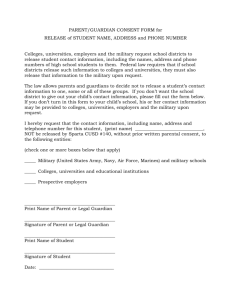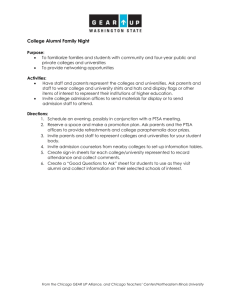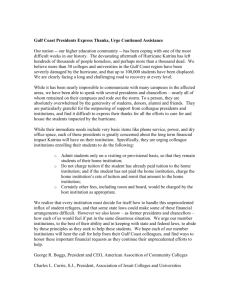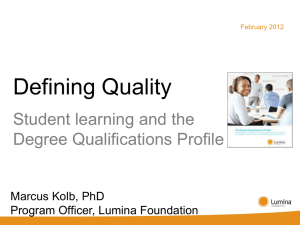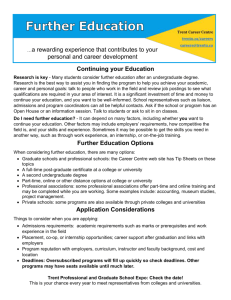Common Application Guide for Students
advertisement
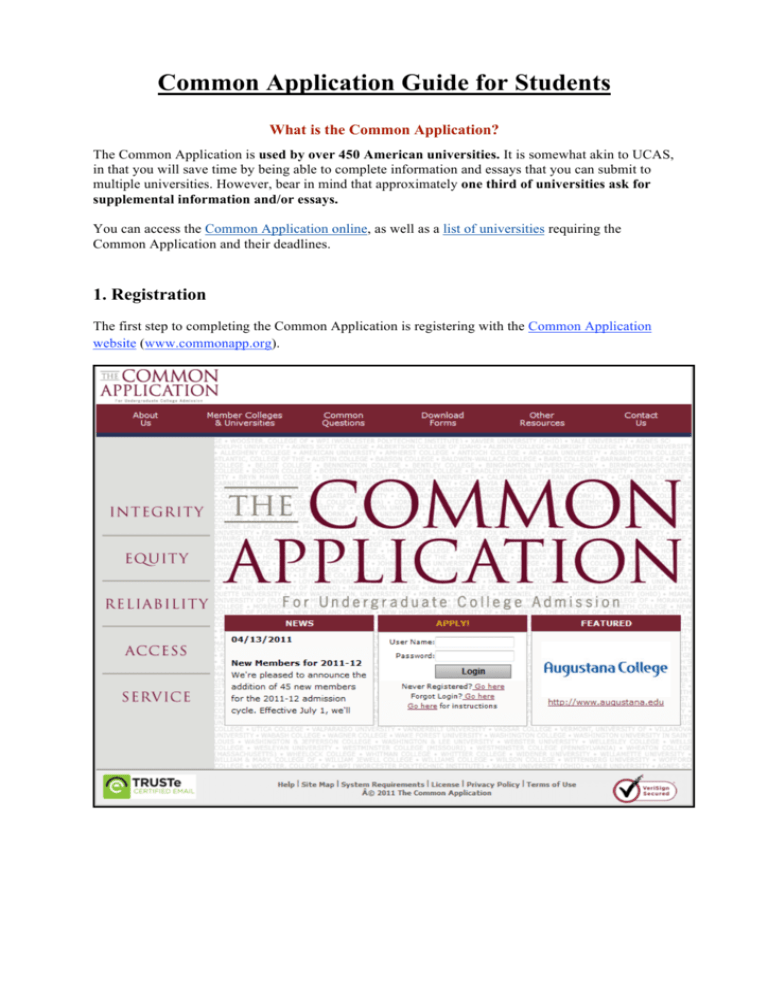
Common Application Guide for Students What is the Common Application? The Common Application is used by over 450 American universities. It is somewhat akin to UCAS, in that you will save time by being able to complete information and essays that you can submit to multiple universities. However, bear in mind that approximately one third of universities ask for supplemental information and/or essays. You can access the Common Application online, as well as a list of universities requiring the Common Application and their deadlines. 1. Registration The first step to completing the Common Application is registering with the Common Application website (www.commonapp.org). When registering, remember to write the date in the American style, with the month coming first, followed by day and year (mm/dd/yyyy). Leave State/Province blank if you live outside of the United States. When typing your phone number, enter the country code (044 for the UK) at the beginning and use no dashes or spaces. 2. Email Confirmation After registering, you will be sent a confirmation email, like the one shown below. Make sure to write down your username and password, as you can sign in and out of the Common Application as many times as you like, saving your work each time. 3. Instructions After logging in, click on Instructions on the left-hand side of the screen. Watch the video demo on the Instructions page (shown below), and read through the Common Application instructions. Also read Fulbright’s webpage with general information and tips on terminology differences (http://www.fulbright.co.uk/study-in-the-usa/undergraduate-study/applying/common-application). Familiarise yourself with the Common Application website, and use the tabs on the left-hand side of the screen to move between sections. 4. My Colleges Under My Colleges, you will select the colleges to which you will apply. Remember that the words “college” and “university” both refer to places of postsecondary education in American English. If you already know the colleges you wish to attend, type their names into the field (shown below) and click “QuickAdd”. Search for Colleges If you aren’t sure which universities you are interested in, use the helpful “Search for Colleges” tool, shown below. In “Simple Search”, you can search by state, area, deadlines and more. You can also see profiles of the colleges if you need additional information. If you want to search by more specific terms, such as housing type, special programs, application requirements or athletics, use the “Advanced Search” tab. After searching for colleges, you can use your “Search Results” to investigate the colleges further. Tick the “Select” box and then compare your selections to other schools, use the “Map” function to see where each is located, or add the school to your list (which will appear under My Colleges). Once you add a university, return to the “Search” to add additional universities to which you plan to apply. Keep in mind that only the 450 Common Application member universities are profiled, and there are over 4,000 institutions offering undergraduate degrees in the United States. For more comprehensive university search engines see the EdUSA website (http://www.educationusa.info/pages /students/search.php). You are able to choose multiple colleges to which you will apply, which will appear in tabs on the My Colleges page. While there is no limit to the number of universities you can apply to, we recommend you focus on 4 – 6 carefully selected universities including a mix of reach, match and safety/insurance universities. See our section on Choosing Universities (http://www.fulbright.co.uk/study-in-theusa/undergraduate-study/choosing-universities) for more on types of universities and factors to consider. 5. Future Plans Now you are ready to begin the actual application. For each college, you will need to decide whether to apply Early Decision, Restricted Early Action, Early Action, Regular Decision (autumn admissions) or Regular Decision (spring admissions). Some universities will only have a few of these options, or they may have them all. Early Decision is legally binding, and you can only apply Early Decision to one college. If your Early Decision choice accepts you, you are legally bound to withdraw all other applications to US universities and enrol at that university. Restricted Early Action is a non-binding admission option where you cannot apply to any other private colleges by Restricted Early / Early Action or Early Decision. The Restricted Early Action choice would, like Early Decision, be for your first choice university. You are not required to withdraw other applications until you know your financial aid offer. Early Action (unrestricted) is non-binding as well, but you can apply to several universities as Early Action. All of the Early application options allow you to apply by an earlier deadline and receive admissions decisions (usually in December or January) well before the usual spring decision date. Early Action and Early Decision admissions are also not conditional on strict, predicted A-level results, but your offer could be withdrawn if you do not perform at or near you predictions. For Regular Decision you will apply by the later deadline. At some universities, you may also apply to start university in the spring (January) using Regular Decision (Spring Admissions). This will be an even later deadline. Please note that each university can set their own application deadlines but generally follow a common pattern: • Early admission applications: October – November (for entry the next autumn) • Regular admission applications: January – March (for entry the next autumn) • Spring admission applications: October – November (for January entry) After deciding when to send your application, answer the rest of the questions on the Future Plans page. Some universities do take financial need into account when making their admissions decision for international students, and we encourage you to be honest so that you are considered for financial aid if you need it to study in the United States. You will also select that you intend to be a full-time student, since you must be full-time if studying on an F visa. The College Housing question is just to help the university with planning, and you will have a chance to explore housing options more fully upon admission. For the Academic Interests questions, it’s OK to be undecided about your major under the liberal arts philosophy followed in the US system. If you have multiple interests, you can do a double major or complete minors alongside your major, and you can indicate multiple interests on the Common Application. Fill in the Future Plans form for each college in My Colleges. Once saved, proceed to the rest of the application. 6. Applicant In this section, you will need to fill out basic information about yourself. Remember to write the date in the American style (mm/dd/yyyy). Leave the field for US Social Security Number blank if you do not have one. Cell means mobile number, and IM stands for Instant Messenger. When entering your mobile or home number, make sure to include a zero at the beginning of the country code if your country code is only two digits (044 for the UK). Once saved, proceed to the Demographics section. 7. Demographics In this section and the following Family section, you will be asked to provide information about your background. If you hold a US Dual citizenship, select “Dual” and then you will be asked to choose your non-US country of citizenship from a drop down menu. Select “Other” as your citizenship if you do not hold a US or Dual citizenship. This will open up extra fields from which you can choose your country of citizenship. Leave the field for State/Province blank if you live outside of the United States. 8. Family In this section you will be providing information on your family and their education. As you know, the US admission process is holistic, taking into account a range of factors in addition to your academics. This information will provide some context about your background for the admissions office. Note that “College” means university. You cannot type directly into the CEEB code field. Click on the question mark and an explanation will appear, shown below. Put in the country, city and school name and click search. If no results appear, search again. Once you have searched twice for the school code, an option will come up on the bottom of the screen (shown on the screen below in red text) to indicate the code as not found. Click the link, which will enter 0000 into the field automatically. The form will then allow you to type in the name of the university in the next field. In the “Degree Received” field, choose the highest degree received by the parent. The drop-down menu will include options for Lower School (secondary school), High School (equivalent to the last four years of school before undergraduate study), Some College (university) and College Degree. Therefore, degree does not mean strictly university degree, so choose the highest education received. If your parent did not attend school, select none (this cannot be left blank). Professional/Graduate School (if any) is postgraduate education. In this manner, complete the rest of the section for both parents/ legal guardians. You may also fill out information for siblings (optional). 9. Education Under Education, you will submit information about your current school or sixth form college. In selecting school representatives, note that in the application you will choose two teachers and one guidance counsellor per college/university to support your application. Most students use the same three individuals for each university. Note the teacher and guidance counsellor cannot be the same person, and they will have access to different forms. The guidance counsellor will submit a school profile and comment on the students’ performance in a broader manner through the School/Final Reports. The two teachers you select will submit a more specific recommendation letter about your academic and extracurricular potential. We recommend that you use your Head of Careers, Head of Sixth Form or Housemaster/mistress as the counsellor and that two current teachers complete your teacher references. Make sure to inform them in advance, and make sure that the email address you submit is correct. Login information for the forms will be sent out to them via email (you do not have to send the forms to them yourself), so it is vital that you have the correct information. As before, for the CEEB code, click “look up” (you cannot type directly into the field) and fill out the information about your current school (remember that in the US the term “school” is synonymous with all types of education, lower school, sixth form and college/university as well). If you can’t find your school, search twice and then a link will come up at the bottom of the page (it will say “Click here if your school cannot be found”). Click the link, which will then enter 0000 into the CEEB code field automatically. Then you will be allowed to enter your school’s information into the remaining fields. For “Graduation Date”, enter the date you will receive or did receive final results for A-levels, IB, etc. For the question asking if you have attended any other secondary schools since ninth grade (ninth grade is equivalent to Year 10 in the UK), tick the box if you are doing A-levels at a different school to where you completed your GCSEs. Then you will list the information for both schools. They will then ask you to list any community programmes that have helped you with your application. If you used one that is not on the list, select “other”, and then you will be able to type it in. If none, leave these blank. Under Education Interruption, if applicable, choose the option that best applies to you. If you have not had any interruptions or delays in your education (other than switching to a different school for Alevels) don’t tick any of the boxes. Note that GED is a US High School equivalency exam. If you do tick one of the boxes, you will be able to upload a document explaining the delay/interruption. Keep in mind that the American term “courses” in the last question on the screenshot shown below means classes or modules. 10. Academics Under Academics, report your best SAT or ACT scores and/or dates you will take the test in the future (even though you are entering the scores into the Common Application, you will still need to send official scores). Graduating Class Size is the number of students in your year group. Please note that you may leave the class rank and GPA questions blank if your school does not provide these, as well as questions about tests not required for most British applicants. TOEFL/IELTS are English language proficiency exams. AP, or Advanced Placement, exams most commonly are offered in US high schools and may not be applicable to you. Note that SAT subject tests are not required by the majority of US universities, but generally are required by the most competitive universities. Check with each individual university regarding what admissions tests they require. For Current Year Courses (qualifications and subjects), list your subjects for A-levels, Higher /Advanced Higher, BTEC, Pre-U, IB or the equivalent (for example: A-level French). If your subjects will be the same for all three terms (all year), put the same list in each trimester column. Under Honors, submit information about any academic honors you have received. When filling out this section, please note that Grade Level 9, 10, 11 and 12 will correspond to British Year 10, 11, 12 and 13 (GCSEs and A-levels). Please also make sure that you preview your application, as some text may not “fit” when it is converted to the PDF version the universities will print. Read the pop-up box about text being cut off, shown below. 11. Activities Under Activities, report any extracurricular activities you have completed in school or in your community. A few examples: school clubs or activities, school leadership roles (Head Boy/Girl), sports you participate in at school or recreationally, arts lessons or performances, voluntary service, work experience and internships. In the drop down menu from which you choose your activity, JV/Varsity means that it was a High School level team (equivalent to the last four years of British education) vs. a professional or recreational team. If you can’t find your activity, choose “other” and then you will be able to type it in yourself. Again, remember to preview your answers as some text may be cut off in the print version universities will see. Also note that on the application, Grade Level 9, 10, 11, and 12 correspond to British Years 10, 11, 12 and 13 (GCSE years and Sixth Form). In choosing to add more activities to your applications (you can include up to 10 activities), you may wish to re-order them at the end in order of importance. You can do so using the Up and Down buttons in the top right corner of the activity box. 12. Writing In this section, you will have a short answer about an extracurricular activity or work experience and personal essay to complete. Both will go to all of the universities you apply for through the Common Application. Be strategic about which activity you choose to highlight, based on the selection criteria for the university. Keep in mind that approximately one third of Common Application member universities will also want you to complete essay supplements to the Common Application, some of which will include additional essay topics. The supplements will be unique for each individual university. You may wish to check the Supplement section for each college you’re applying to, and consider all of the essays and the short answer together to ensure that you are not repeating yourself and that they are complementary to each other. Another strategy is to choose the activity you’ve been involved with the longest, taken leadership roles in, that means the most to you personally or to your career plans, etc. Remember to preview your work when you finish to ensure that your answers will not be cut off. Note that for the personal essay, this will be seen by all colleges you apply for (as explained above). Do not make your personal essay specific to one college as you will be able to do that in the supplements. See Fulbright’s website with sample essays and essay writing tips (http://www.fulbright.co.uk/study-in-the-usa/undergraduate-study/applying/essays). For “Additional Information”, this is where you can upload a document that explains any discrepancies or negative circumstances that may have affected your marks or extracurricular involvement. 13. Supplements Check to see if the universities you are applying to require supplements, additional information or essays that you will need to submit along with the Common Application form. Some will let you submit the supplements online or by email, and others may ask that you mail your materials to the university. Supplements will differ from university to university. When filling out your details, you may leave the Social Security Number blank if you do not have one, as well as State/Province if you live outside of the United States. Here is an example supplement for the University of Pennsylvania: 14. School Forms This section will be where you give information about your two teachers and guidance counsellor (see above information in step #9 for an explanation of differences between teachers and counsellors) who will recommend you and provide your school forms to the universities to which you are applying. After authorising your schools to release your academic information, we recommend that you waive your right to access in the Privacy Notice to maintain credibility of the letter in the eyes of the university. Then sign and date the form. After clicking “Save”, you will be taken to the page shown below. Click “Invite Official”. Remember, most students use the same three individuals for each university. Note the teacher and guidance counsellor cannot be the same person, and they will have access to different forms. The guidance counsellor will submit a school profile and comment on the students’ performance in a broader manner through the School/Final Reports. Teachers will submit a more specific recommendation letter about your academic and extracurricular potential. We recommend that you use your Head of Careers, Head of Sixth Form or Housemaster/mistress as the counsellor and that two current teachers complete your references. Make sure to inform them ahead of time that you will be asking them to write a reference, and make sure that their email is correct. Login information for the forms will be sent out to them via email (you do not have to send the forms to them), so it is vital that you have the correct information. Again, we suggest you tick the box to release authorisation to maintain credibility of the letter in the eyes of the university. Click “Send Invitation”. After inviting the counsellor, you will be required to select the two teachers who will write letters of recommendation for you. To add teachers, click “Invite Official” again, select “Teacher”, and then fill out their details. You can then select the teacher from the drop down menu on the page shown below. Do this again for the second teacher. After you have completed this, go back to My Colleges. 15. My Colleges Fortunately with the Common Application, you won’t have to re-type your biographical information for each application; these fields should auto-fill for you. You will have to choose which deadlines you will apply by for each university (Early Admission, Regular Decision, etc.), fill out the supplements and send the school forms again. Double-check each application to make sure you aren’t missing any steps. 16. Signature In the signature section, you will be prompted if there are any parts of the application you forgot to fill in or filled in incorrectly. 17. Payments After you have completed the application, go to the Payments section to pay the application fees. You can pay each university application online. If the application cost is prohibitive, you may contact the individual university admissions office for information on how to request a fee waiver and if you qualify. The Common Application also links to the following fee waiver sites from their “Other Resources” tab on the home page: http://sat.collegeboard.org/register/sat-fee-waivers and http://www.nacacnet.org/studentinfo/feewaiver/Pages/default.aspx.
